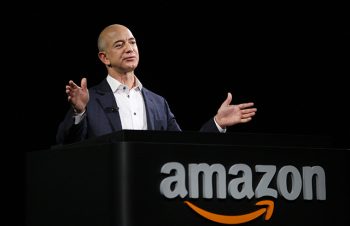By Professor Dennis R. Shaughnessy
Earlier this month Amazon announced it would increase its internal minimum wage for full-time, part-time and seasonal employees to $15 per hour. That’s more than twice the Federal minimum wage. As many as 250,000 employees will get a raise starting November 1, with many “blue collar” workers at Amazon receiving nearly a 50% raise.
We’ve long advocated for businesses to lead the way in ensuring that someone who works full-time doesn’t live in poverty. The high costs of housing and health care make it virtually impossible for someone to live a dignified life at the Federal minimum wage of $7.25 per hour. It’s been nearly a decade since the last increase in the Federal minimum wage (though many states have enacted higher minimum wages). Amazon’s decision is an important step in addressing the vast and growing income inequality gap between low skilled workers and management/owners (shareholders).

Jeff Bezos, CEO and founder of Amazon.
Some critics noted that Amazon made cuts in its stock award program and bonus plan for hourly workers while implementing this new minimum wage. However, it appears that the cuts are far outweighed by the increased wage rate. Others suggested that Amazon was trying to avoid Federal legislation re-setting the minimum wage to $15. Still, others suggested that $15 an hour isn’t nearly enough to raise a family in high cost cities like Seattle, San Francisco or New York.
Progress often happens slowly and incrementally, to be sure. Amazon took a rare big step forward. The next step will be for other companies to follow Amazon’s lead. Target and Walmart have increased wage rates at the low end of their pay scale, but not as rapidly or as aggressively as Amazon.
Economists tell us that with a 3.7% unemployment rate nationally, there is finally pressure on the labor side of the stakeholder equation to increase wages. Lower skilled workers are in high demand, so wages for the jobs these workers fill should rise in response. Amazon’s rapid growth suggests the company is likely experiencing this pressure intensely, explaining the wage increase for physically demanding jobs in its fulfillment centers (warehouses).
Shifting gears a bit, while we often read or hear about the unemployment rate, it doesn’t tell us the full story of employment and job creation. We know that there are other technical measures of employment, like the “labor force participation rate” which measures the number of workers who are not actively looking for work. If that number increases, then the unemployment rate in turn tends to decrease even if the number of new jobs created remains at a steady rate.
What we need in this age of inequality is an easily understood companion number to accompany the unemployment rate, namely a simple measure or index of “job quality”. The unemployment rate doesn’t capture whether a job is stable, offers genuine opportunity and allows a worker to earn a fair wage. For example, full-time permanent jobs that pay a living wage, offer health insurance and other benefits (parental leave, education and training subsidies, a savings plan) would receive the top rating or grade. Temporary jobs that pay well below a living wage, without benefits and in line for replacement by technology (AI, robotics) or offshoring would receive a lower grade. This would allow us to see an index of job quality alongside the unemployment rate, giving us a more complete measure of the health of the economy and progress towards reduced income inequality.
For example, next month we could see a 3.6% unemployment rate with a C overall job quality rating (using the traditional academic letter grade system). This would suggest an abundance of jobs but at low wages with few benefits. We could then focus less on adding more low quality jobs and more on increasing the quality of existing jobs.
We will surely see progress as more and more workers are paid a living wage. But we will see even more progress as workers settle into high quality jobs that help revive the American dream of upward mobility. Businesses committed to worker dignity and social responsibility should lead the way.


